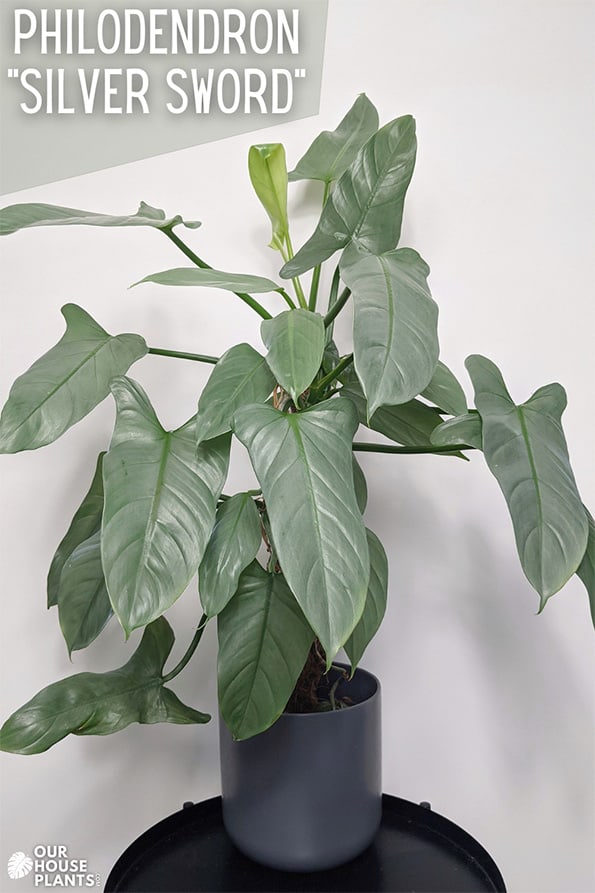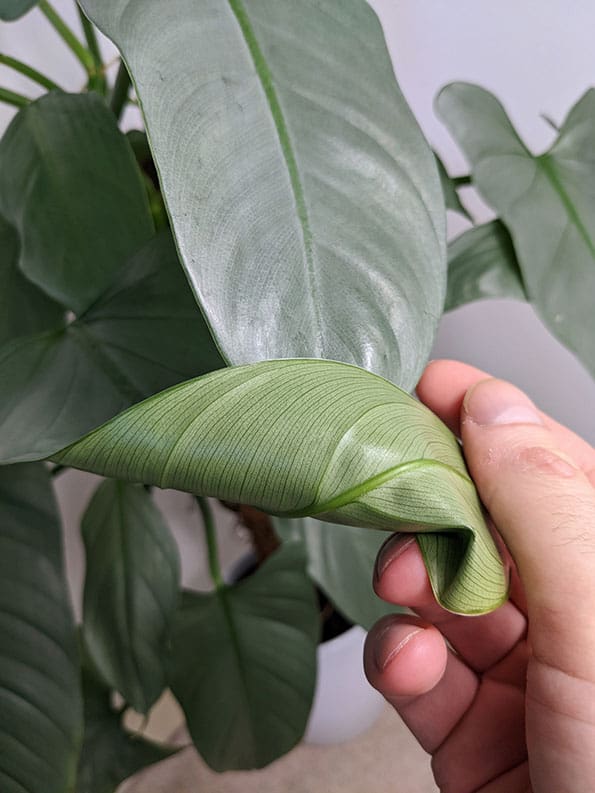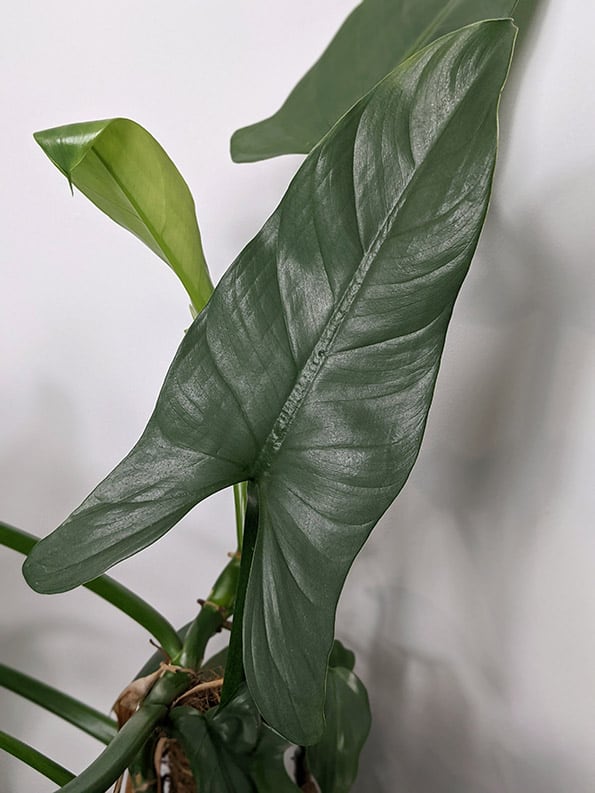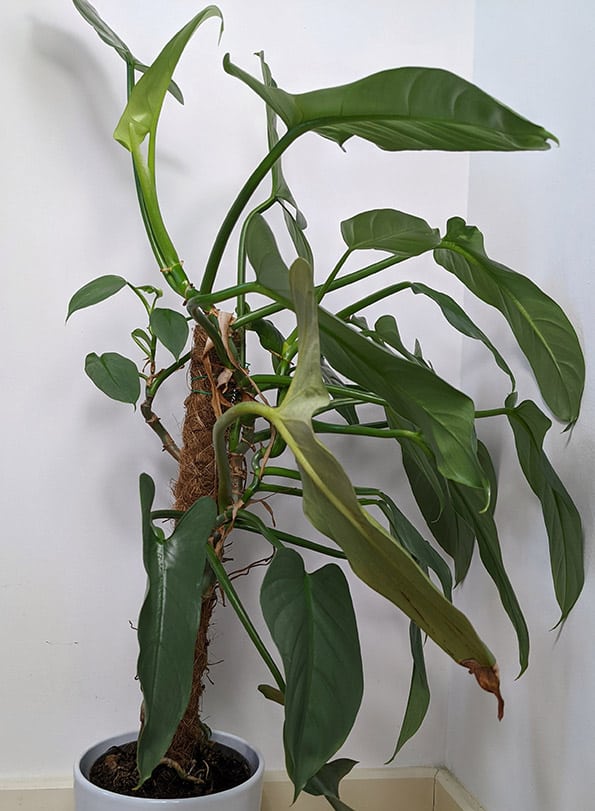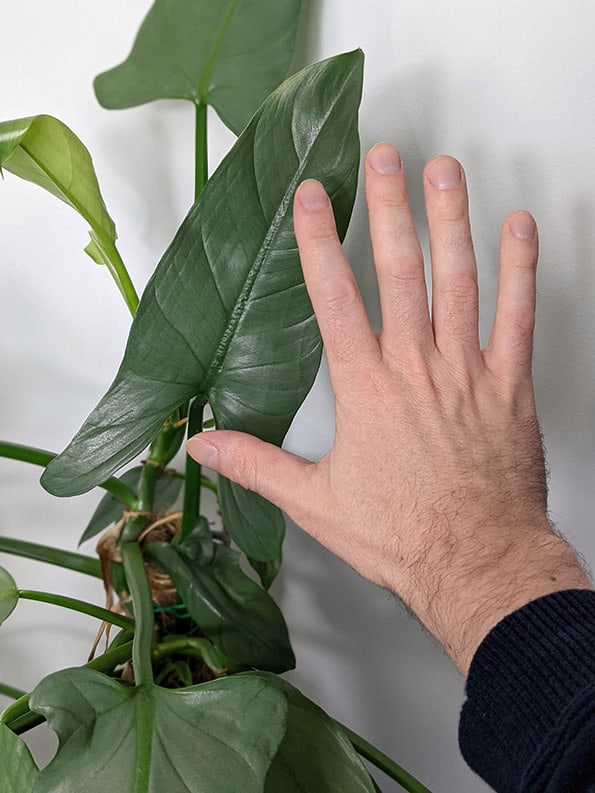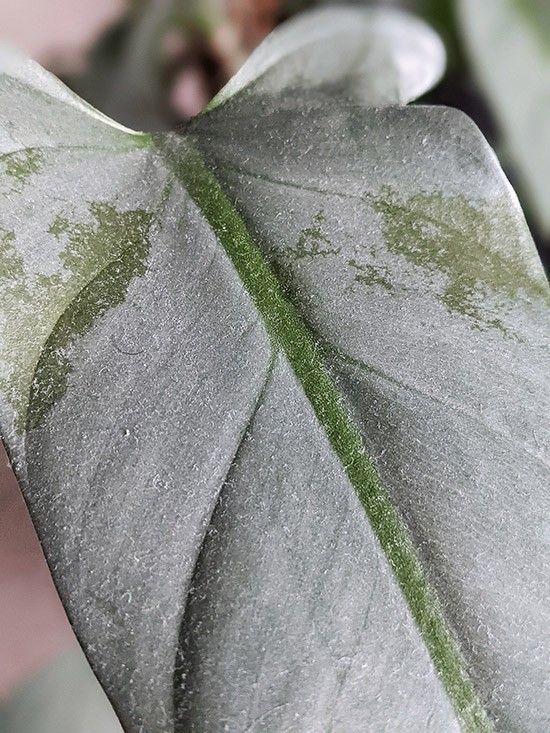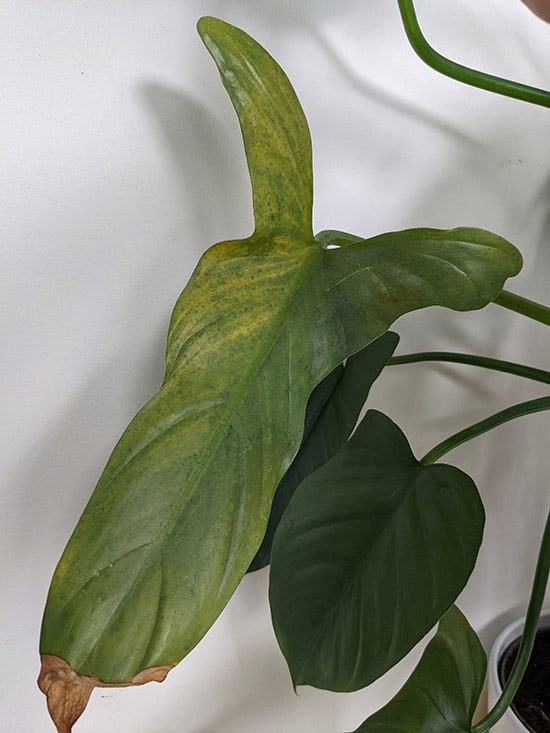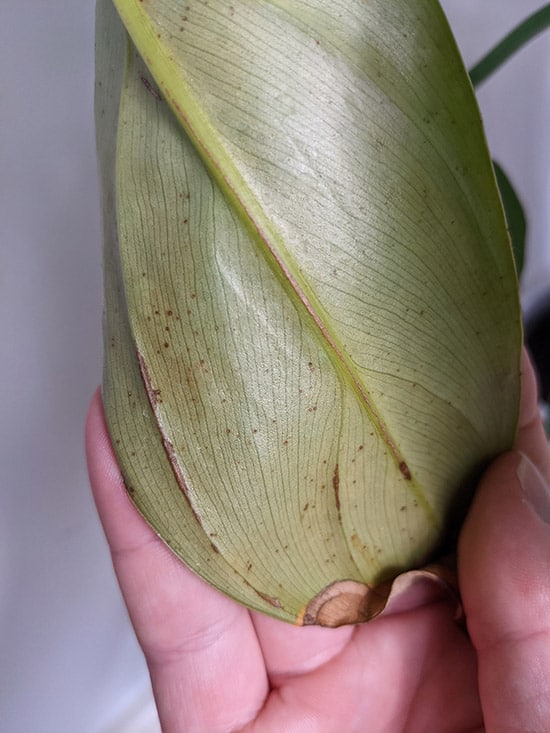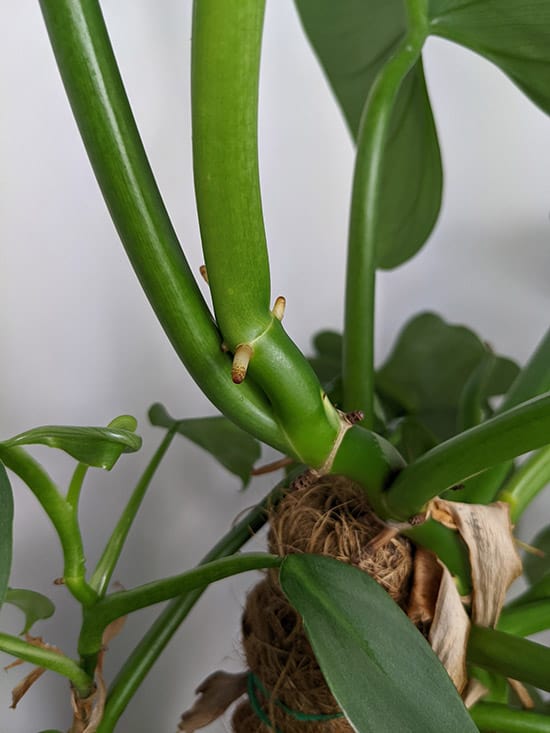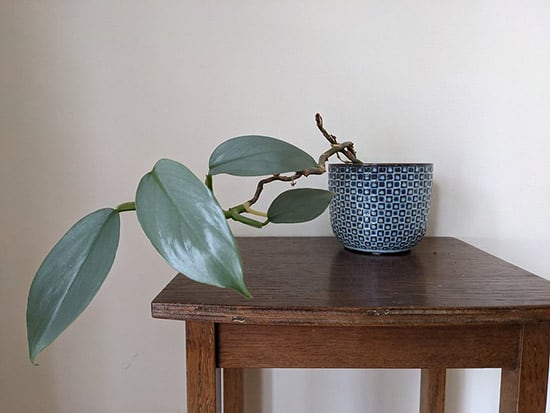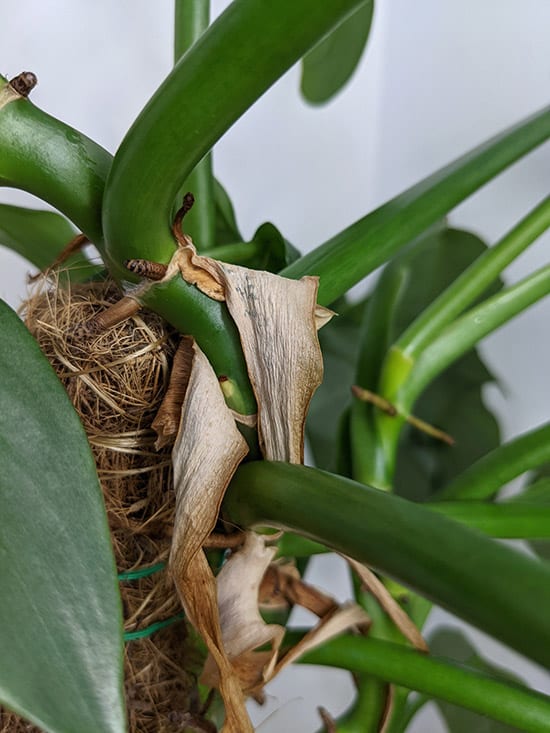The Philodendron Silver Sword, also known as Philodendron Hastatum, is a stunning and sought-after houseplant. Desired for its striking, silvery-blue foliage and unique sword-shaped leaves.
It's a slow growing climbing plant, but with reasonable care, the leaves will eventually grow to an impressive size. It's often used indoors to add a modern indoor jungle aesthetic.
Philodendron Silver Sword is relatively easy going and will make a good choice for collectors and plant enthusiasts looking to add a statement piece to their collection.
It's a resilient plant and will thrive in bright, or indirect light and moderately moist, well-draining soil.
The plant is a climber rather than a vining Philodendron, so it doesn't grow very well as a trailing or hanging houseplant. Instead, if you want it to look at its best, you'll need to provide a moss pole (or some other climbing support) for it to grow properly.
While it can be a little fussy with its care and eventual requirement for climbing assistance, the unusual looking leaves will get larger, and it has a captivating indoor tropical aesthetic that often makes it worth the effort.
Philodendron Hastatum can be brought either as a tiny juvenile plant (often cheap), a smallish plant growing on a moss pole already (medium price) or a huge plant either in a standard planter without any growing support or with a support.
Are there different varieties?
There are probably no true varieties beyond the original and the variegated ones.
You may spot trading names or labels calling it "Philodendron Domesticum" or "Silver Queen" which could imply you have a unique variation. But Philodendron Hastatum is well known to experience morphological variation. This means it will change its appearance depending on its growing conditions and maturity level.
Prices are usually above average compared to other houseplants.
This is down to the uncommon nature of the Silver Sword rather than because it's super rare or difficult to grow.
Although wild plants from the rainforests of Brazil feature on the endangered species list, within the houseplant trade, it's quite widespread.
It's not a specialist houseplant and it will still appear in box stores or larger garden centers (which is where I found mine) from time to time.
You might stumble across P. hastatum variegatum (sometimes called Variegated Philodendron Domesticum), a super rare variegated variety, but because it's so uncommon this will require you to search out a specialist seller.
Two leaves side by side, one shows the back of the leaf so you can easily see the color contrast with the metallic-looking foliage to the front of this stunning plant.
The leaves have a silver sheen that, in most light conditions, has a hue of blue mixed in, giving an almost metallic look.
The contrast and color can be hard to see in photos, but I've provided a contrast in the photo above, where you can see the silvery look against the normal green on the underside.
The sword shaped elongated leaves with strong visible tri-lobes at the bottom of the leaf will appear as the plant ages. So it's perfectly normal to have more basic looking juvenile leaves that are loosely arrow-shaped when the plant is young until it matures.
Of course, you do need to provide proper care for the plant to reach its potential and I'll be covering the Philodendron Silver Sword care next.

Hi, I'm Tom!
If you're like me and enjoy the challenge of growing houseplants and getting them to thrive, then Ourhouseplants can help. This website shares my knowledge and years of growing plants and provides (hopefully) helpful advice on properly caring for your indoor plant friends.
The Philodendron Silver Sword will do well in bright or medium light levels, making it an ideal houseplant for indoor spaces.
It will really thrive if you can up the light levels and put it somewhere where it receives filtered sunlight or dappled light (direct early afternoon sun could be too much for the silvery leaves). This will help maintain the silver-blue foliage and allow it to produce good levels of growth and become a bigger plant.
It can tolerate lower light levels but its coloration and growth could be suboptimal in these conditions. I've only ever had bad experiences with mine when trying to grow it in lower lit areas. So it's medium levels as a minimum for me and I can't recommend anything lower than this based on my experience.
Watch me chatting about my Silver Sword plant over on YouTube.
Its watering needs are standard and similar to most other Philodendron plants. Water it well and then wait until the top few inches of potting soil have dried out before you water it again.
Expect to water it less in winter when it's water needs are reduced.
As with all houseplants there are ranges and exceptions to this rule. The Philodendron Silver Sword is reasonably tolerant with watering, it does struggle with heavy overwatering (yellowing leaves and leaf drop are early signs of root rot) so do take care there. But it can dry out completely for a few days and bounce back without ill effects.
The main issues with watering come when you're trying to grow it in lower light, the temperature is cooler and you're not letting the soil dry out enough. I'd say winter is dangerous for these plants as excess water can easily finish it off, so be extra careful over this period.
They are tropical plants adapted to high humidity, but as with most of its care requirements, it will still take a broad range of conditions.
You should be OK with most humidity levels as long as they don't fall much below 40%. If this happens frequently where you are, look for brown leaf edges and tips. If they show up, you're going to need to find ways to boost humidity near your plant.
This is a reasonably hungry houseplant. It's not a gross feeder, but it will need feeding, at least bi monthly, over the growing periods in Spring and Summer for the best results.
It won't make too much fuss if you feed it less frequently but you may notice it stops growing.
Good light and correct watering is the best way to get healthy and impressive foliage, but using a balanced liquid fertilizer every month will help new leaves grow.
Daytime temperature somewhere between 15°C (59°F) and 35°C (95°F) should be the goal. The plant does need warmer temperatures to grow, so if the temperature is hovering around the lower end of this range it's unlikely you will get new growth.
It's not a cold tolerant plant so try to avoid anything below 10°C (50°F).
Even if you're providing the right conditions, the roots will take a while to fill a pot completely. Even large plants with many leaves may only have a basic root ball under the soil. A repot is often done when you want to add a larger moss pole, rather than because it's outgrown the existing container.
That's not to say they never need repotting. When the plant stops growing, a large amount of root is coming from the bottom of the pot or you can see the potting mix is breaking down, it's a good time to do it. Anything from 2 to 4 years is typical.
The Silver Sword is a hemiepiphyte. This means it has some epiphyte qualities, like aerial roots that can absorb water and nutrients from other mediums than soil. But it's not a true epiphyte and can't live like this forever.
Water Growing Candidate
The Silver Sword can be grown fully in water for a number of years. However it will never get as large as plants growing in a potting mix. This could be the aesthetic you're after though. If you want to learn how to do it, read our growing in water guide.
In terms of growing it at home, it can cope with some heavier potting mixes with some organic matter like earthworm castings. Other Philodendrons need free draining and open mixes, but the Silver Sword will do fine in standard potting compost.
By all means you can of course use a more open or Philodendron / Aroid mix if you want, but it's not essential for a healthy plant.
The most common method of propagation to get a new plant or two, is through stem cuttings. Here's a step-by-step guide.
Select Healthy Stem Cuttings: Choose a healthy, mature stem with several leaves. Look for a section that's at least a few inches long, ensuring it has nodes (the small bumps on the stem where leaves and roots grow out of).
Take Cuttings: Use clean, sharp scissors or pruning shears to make a clean cut just below a node. Cuttings that are around 6-8 inches long with some leaves are ideal.
Remove (Some) Leaves: If there are more than 4 or so leaves, you might want to trim away the lower leaves, leaving a few leaves at the top of the cutting. Because there are no roots at this point, having too many leaves means the cutting might not be able to support this much green growth at this stage.
Water Propagation
You can also try and propagate using water instead of soil. Put the cuttings in a vase of water (only a striped stem should be submerged i.e. no leaves should be touching the water). Once roots have formed, you can transplant to a potting mix).
Plant Cuttings: Fill a small pot with well-draining potting mix. Insert the cuttings about an inch deep into the soil, and gently press the soil around them to secure. You may need to use other supports like strong sticks etc to help things stay in place (a full moss pole at this point is probably excessive and a waste of space, but I have seen them used).
Provide Indirect Light and maintain Moisture: Place the pot in a location with bright, indirect light. Keep the soil just moist.
Hang Tight and Wait: After several weeks, the cuttings should have developed roots. Once the cuttings have a good root system, you can transplant them into larger pots and provide standard Silver Sword Philodendron care going forward.
The Silver Sword Philodendron is an average grower at best. Other Philodendron species like the Brasil and Micans are fast growers and will produce multiple leaves quickly over the growing season.
With the Silver Sword, you'll get a handful each year at the most. If it's any consolation, the leaves will be a lot bigger than those on the Brasil and Micans.
Sideways photo to show the Silver Sword plant tends to have a clear front and back.
These plants have a fixed front and back. So because owners often want even, rounded foliage in their houseplants the growth habit of these plants can sometimes frustrate people.
Ultimately, they will primarily face in only one direction and owners need to accept this. Other large leaved houseplants like the Monstera (Swiss Cheese Plant) do the same thing. So it is fairly usual in the plant world.
Did You Know?
The name "Philodendron", which was derived from phileo - to love, and dendron - a tree, referred to their tree-climbing habit.
In their native habitat they would be climbing up a tree (or similar) with the leaves all facing outwards and away from the tree truck. You can't do anything about this growing trait, so find a corner or place it against a wall to show it off.
The plant's size is limited when grown in pots or containers with minimal upward support. When grown vertically on a simple support structure, they tend to reach greater heights, anything up to 5 feet (1.5 meters) is normal.
Using a thicker moss pole / coconut coir totem, you can get even taller plants. These are often hard to come by and you may have to make your own frame and fill them with coir or sphagnum moss.
If you then keep this pole damp, the aerial roots will grip and hold on better, this will encourage taller and higher growth. Read this if you plant isn't holding on or gripping the support.
The spread or width of the plant can also vary. It can extend 2 to 3 feet (60 to 90 cm) horizontally if allowed to sprawl instead of climb upwards.
Trimming back leggy or excessively long stems can promote a bushier appearance and limit its overall size.
My hand next to a Philodendron hastatum, for a size comparison showing the newest leaf is bigger than my hand. You can also see the thick stems holding the glossy foliage in place.
The leaves will get bigger quickly. I've had my own plant for over 3 years, and the leaves it's pushing out today are already bigger than my hands and they will keep getting larger.
Like many Aroids, flowering is possible indoors. You may notice a long and fat growing mass close to the main stem. Sometimes the flower bud doesn't get to the flowering stage and just falls off, but if it opens you will see a flower similar in shape to those on the Peace Lily. Thicker but less attractive though.
The plant contains calcium oxalate crystals, which, if chewed or eaten, can cause a range of symptoms, including oral irritation, gastrointestinal distress and in some cases more serious issues (but this is rare). Better to be safe rather than sorry, so keep it away from pets.
The large leaves are dust magnets. Leave them long enough and you'll be growing your very own Dust Bunnies.
Fortunately, because of their size it's easy enough to clean the leaves with a damp cloth. You can also put them outside during a rain shower (when it's warm enough), or take them to your bathroom for a quick shower.
Close up showing the leaf surface on this Silver Sword houseplant is covered in dust. Regular misting can help keep the leaves clean, but because this plant has big leaves its probably easier to just wipe them down.
I need to give mine a wipe every 3 months or so. It's important to keep the leaves clean as the dust can block light from getting to the leaves.
Yellow Leaves.
There is potentially something wrong if you have yellow leaves on your Philodendron Silver Sword. The leaf will yellow up and easily separate from the chunky side stem, which will often go yellow too and fall from the plant's main stem later.
Yellow leaf on a philodendron hastatum plant.
There are quite a few things that can trigger this. Here are the the more common reasons.
Thrips
Thrips can be a serious problem for most Philodendron plants. They're part of the Araceae family, and unfortunately Thrips absolutely love them.
If you have yellowing leaves with a mottled pattern like you can see above, flip the leaf over and look at the underside. If you see something like the below, then you likely have a Thrips issue.
Thrip damage on the back of a Silver Sword leaf. The small insects feed off the sugars within the leaves and leave behind damage which goes brown.
You need to tackle them fast or they will destroy your plant and could spread to others in your collection.
Neem oil, and insecticidal soap can both help. Although in most cases these things are not powerful enough to disrupt the Thrip life-cycle and a systemic insecticide is often needed. I have a more detailed article which will teach you how to get rid of Thrips.
Silver Sword not climbing the support pole by itself.
This type of Philodendron can be trained to climb and is typically well-suited to trellises and support structures. So if your Silver Sword is not climbing the support pole by itself, you can take some steps to encourage it to do so.
Position the Plant Near the Support: First, make sure the plant is positioned near the support structure. You can gently guide the stems towards the pole.
Secure the Stems: Using soft plant ties or twist ties, loosely secure the stems to the support structure. Be gentle to avoid damaging the plant. As it grows, you can adjust the ties to provide more support.
Provide Adequate Light above the plant: Ensure the plant is receiving sufficient light. A well-lit environment encourages the plant to grow towards the light source, which, in this case, is up your support pole.
Be Patient: Training a plant to climb can take some time. But with patience and care, it should start climbing the support as it matures.
Silver Sword Philodendron plants have a climbing growth habit and you will spot small aerial roots on the stems. The easiest way to help it achieve its climbing plant potential is to secure the stems close to the support structure so the aerial roots can grip in.
Small leaves
If your Silver Sword is young then it will have small leaves at the start. If you're growing it properly, over time as it ages each new leaf it produces should be equal or bigger than the last.
If this isn't happening then in the first instance I would be asking if the plant has a moss pole, or something to attach and climb upwards. In the photo below you can see a long thin stem with small shaped leaves with no climbing support. This is why the leaves are small in this example.
Small leaves and thin stem on a Silver Sword indoor plant. It will need some support before it will start producing the arrow-shaped leaves - Photo by BlueLeaf22
If you do have a moss pole in place, then the small leaves could be a sign of insufficient light or feeding. It might also need a repot.
Brown sheaths / brown leaves
Brown leaves can be a normal end to a leaf's life and not something to worry about. However it can be caused by long term underwatering or sun damage.
If you have brown bits hanging down from the stem like you can see in the following picture then it's fine. When a leaf emerges, it has a protective sheath that the plant eventually discards. Just get your fingers in there and pull them off once brown and dried.
Brown sheath issue on a Philodendron Silver Sword. Although it's generally a low-maintenance plant you will still need to pull these off from time to time.
The Silver Sword Philodendron plant is pretty easy going with serious problems. Most of the issues you'll come across just alter how it grows and these can be sorted out.
As you can see, few are serious problems. But if they do show up, tackle them early and you will have a stunning Philodendron for years to come that any plant lover would be proud of.
Credit for the small plant on a wooden end table to BlueLeaf22
